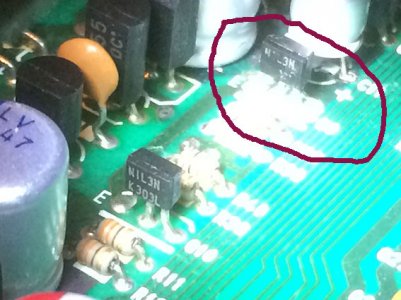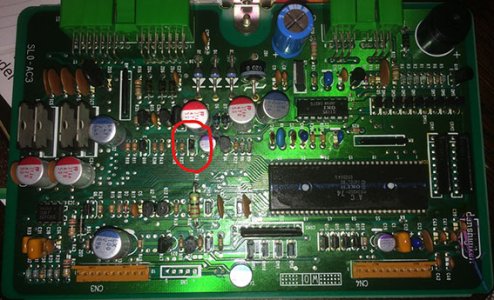We have arrived at an interesting world where one vendor's lot or production facility number matches up with another vendors part number. The common practise (but not religiously adhered to) is that the part number precedes the lot / production number. If I had searched for N1L3N instead of NIL3N (NIL3N yielded nothing sensible) the likely candidate would have been obvious since the K303L N-FET is a super obscure piece only listed by an equally obscure vendor, so I would agree that N1L3N is likely the correct part #.
N1L3N appears to be currently available in (at least) 3 different packages AN1L3N, BN1L3N and GN1L3N. The A package is a TO92 package and the B package is the squished version of the TO92 (which looks like what is used in the CCU). In a pinch the TO92 package (AN1L3N) could be substituted for the BN1L3N. The GN1L3N is an SMD package. Substitution of the G package would require that you make a little adapter circuit board so that would be an absolute last resort.
None of the packages are available from the really common vendors (Digikey, Mousser, Allied ...). They are available from some less common vendors; but, come with significant minimum order requirements. The one vendor had a really odd minimum order count of something like 962. I am thinking that they want to clear out all of their remaining stock and if you want one, you need to take all of them. The other vendor had a lower minimum order; but, much higher unit price so the net cost was about the same. With shipping you are probably looking at $200 or more whether you want 1 or 962 pieces. AliExpress has a vendor listing for AN1L3N for 100 pieces going for about $22 with free shipping. That price is more reasonable; however, my experience with free shipping from the Chinese mainland is that delivery is measured in months, not days. I have no direct experience with AliExpress as a retail platform or the quality of the product that is offered (there is good Chinese stuff and junk Chinese stuff).
With a single transistor, as long as the package is compatible, you respect the polarities and the device type, BJT, Darlington, FET, IGBT ...., it is normally fairly safe to substitute by up sizing with the same or greater Vceo, Ic and power dissipation. However, the N1L3N is not a single transistor. It is a single transistor with an internal biasing network for the base circuit (the two resistors that Kaz mentioned). Suitable 'equivalents' are available from Toshiba, Nexperia and a few others. I didn't look very hard; but, this one from Nexperia looks like it would meet the performance requirements
https://www.nexperia.com/products/b...ets-100-ma-single/series/PDTA143X-SERIES.html
Unfortunately, it is an SMD device (SOT package) as are all the others that I happened to look at. This means that you would have to fabricate a tiny 'daughter card' to mount the SMD on and then solder the daughter card in place of the transistor.
So, if it turns out that the N1L3N is dead, fixes are available; but, none of the fixes are straightforward because of quantities, prices, packing and vendor questions. Trying the repair without replacing Q9 is the way to go just because getting a replacement is going to be a hassle.











